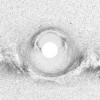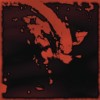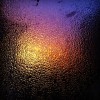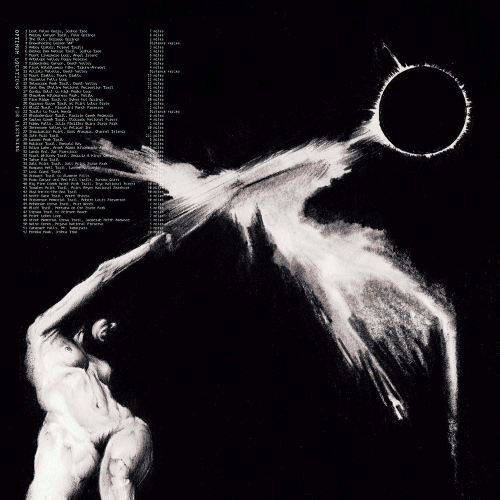Four releases from a shiny new label devoted to something like sound-art, but not as asceptic and dry as that genre has a habit of implying. Hopefully, label head Seth Cooke is already known to Freq readers, but if not his is a formidable CV – sometime Freq writer, engine, petrol and tillerman for Bang The Bore, previously one of spazzy rock’s finest drummers (Hunting Lodge), an improviser of God knows how many outfits, episodic A Bander, contemporary composition performer (mostly on the Wandelweiser side of things), conceptual sound-art tickler and probably a raft of things I’ve forgotten.
Before I start cooking the meat of the corpus, it’s worth pointing out that the label, thus far at least, is pretty concept-heavy. Concept is often a perilous matter – sound-art/experimental/whatever tends to rest atop well-articulated concepts but if there’s not much attention paid to whether or not it’s worth following through the concept, it can seem less like a mighty polemic from the balcony of the empire and more like a dickhead on some mouldy tarp at speaker’s corner. Seth’s well aware of this and, perhaps with a wry smile, has managing to slip out some decent concepts and some great music wrapped up nicely in proper packaging (rather than the dreaded “will this do?” of many smaller labels).The label’s called Every Contact Leaves a Trace and the packaging is almost parodically literal in its tie to the label name. Soft brown cardboard clipped around inner sleeves with embossings from various objects – contacts leaving traces on the outside; inside, good card with artwork and inside that, transparent sheets of paper with scant descriptions of the works.
 There’s no numbering to the CDs so it probably makes most sense to start with Seth’s – in which we get four tracks, “CERO I-IV,” of no-input field recordings. Now, concept-speak: ostensibly, this could so easily have been a jokey convolution of two avant-tropes. No-input recordings have been doing the rounds a while now – it’s probably more than a decade since Toshimaru Nakamura got us excited by the prospect of letting gear do funny things to itself. I suspect there’s an appeal to things which live between automatons and minimal agency, though it seems to me like the mutation of self-generating feedback loops is closer to orthodox instrumentality than the initial liberation seemed. Field recordings are… frankly, I’ve rarely not found field recordings dull as piss. You stuck a microphone in a field and you’re self-satisfied. Fuck off. It frustrates me because it’s very rarely done with the elegance and affection (and sadly, expensive gear) that Chris Watson does it with. In terms of music, as with visual art, I’m not interested in flat representation – I want magic and blood, not wedding photographers.
There’s no numbering to the CDs so it probably makes most sense to start with Seth’s – in which we get four tracks, “CERO I-IV,” of no-input field recordings. Now, concept-speak: ostensibly, this could so easily have been a jokey convolution of two avant-tropes. No-input recordings have been doing the rounds a while now – it’s probably more than a decade since Toshimaru Nakamura got us excited by the prospect of letting gear do funny things to itself. I suspect there’s an appeal to things which live between automatons and minimal agency, though it seems to me like the mutation of self-generating feedback loops is closer to orthodox instrumentality than the initial liberation seemed. Field recordings are… frankly, I’ve rarely not found field recordings dull as piss. You stuck a microphone in a field and you’re self-satisfied. Fuck off. It frustrates me because it’s very rarely done with the elegance and affection (and sadly, expensive gear) that Chris Watson does it with. In terms of music, as with visual art, I’m not interested in flat representation – I want magic and blood, not wedding photographers.
For “CERO III” whatever agency or ghost is tweaking the mic’s guts produces something like a c. 1990 hoover synth stuck in a particularly dusty vacuum cleaner. In a blind-test, devolved from the concept, you might mistake these for noise records but there’s a great deal of giving accidents their textural space – agency is afforded to the location and I gather there’s been some careful selection to the extent that the complexity of the textures leaves moments of formidable… luck, I suppose. “CERO IV” has a sound not dissimilar to the sort of spectral massed brass Horatiu Radulescu articulated. “Luck” is a misleading term, because it’s quite clear that Seth isn’t someone to let weak stuff out – arguments over agency be damned, these are seriously compelling recordings.
Next up, Henry Collins‘ Music of Sound, for which the complete notes read: “Music of Sound. The Sound of Music (20th Century Fox, 1965), speech and songs redacted. Conceived & edited by Henry Collins, 2003.” As with Seth’s CEROs, the description is as plain as can be. It’s a simple concept, and it’s executed with no apparent interference. Just the audio from The Sound of Music, but no music and no speech. I think there’s a couple of important things here – what’s being listened to is the careful and assiduous work of film Foley and recordists at a massive remove from the convenience of exacting studio editing. It’s a phenomenally well-known film where Collins has patiently uncovered hidden artistry without any recourse to perversion or modernising. At the risk of letting sentimentality denude itself to hyperbole, it’s a gorgeous gesture of giving those ’60s recordists their moment in the sun without patronisation or so much as a hint of pastiche. It’s a simple idea, but it’s by no means flat or flatulent.And there’s a really good bit of shadowplay for me – I fucking love The Sound of Music – so the narrative ekes in and out, like watching the story gloopily melt through the closed door of a defrosting fridge. Incidental matters – storms particularly – take upon a matter of urgency where previously they were supplementary to the narrative, but without anything so significant as a resolution. Navigating that oscillation – between signified and empty presence – makes for an astonishing record. And, of course, if you’re not in the mood for anything as haughty and concept-heavy as that, it’s simply beautiful to listen to the studio magic of folk probably long-dead and forgotten.
 Next: Ignacio Agrimbau. Agrimbau plays in Southampton’s After the Rain, a group who are genuinely without comparison in the UK (or abroad, to my knowledge) – mixing traditions that typically don’t mix: tape noise, found sound, Farsi singing, Iranian classical violin, West African percussion, jazz-classical broaching figured/extemporised bass and more besides. The point with After the Rain is that they’re very specific about the traditions they mix, and even if they’re unconventional configurations, there’s no sense of simulacra or superficiality with their music. Totally coherent but totally from some headspace that I don’t think another trio’s reached. I can’t recommend them highly enough. Agrimbau’s solo work here lacks, perhaps, the almost vicious contraposition of colour that After the Rain have but is by no means deficient. Anatomy of the Self Volume 2 perhaps alludes to what I’m getting at there – with a limited number of elements, Agrimbau is on a trip into limitations, distortion and ruin.
Next: Ignacio Agrimbau. Agrimbau plays in Southampton’s After the Rain, a group who are genuinely without comparison in the UK (or abroad, to my knowledge) – mixing traditions that typically don’t mix: tape noise, found sound, Farsi singing, Iranian classical violin, West African percussion, jazz-classical broaching figured/extemporised bass and more besides. The point with After the Rain is that they’re very specific about the traditions they mix, and even if they’re unconventional configurations, there’s no sense of simulacra or superficiality with their music. Totally coherent but totally from some headspace that I don’t think another trio’s reached. I can’t recommend them highly enough. Agrimbau’s solo work here lacks, perhaps, the almost vicious contraposition of colour that After the Rain have but is by no means deficient. Anatomy of the Self Volume 2 perhaps alludes to what I’m getting at there – with a limited number of elements, Agrimbau is on a trip into limitations, distortion and ruin.
It’s a bottom-heavy record, with three shortish tracks leading into the mammoth 30 minutes number “We Have Come Here to Lose Control”. The motherload – masses of sustained duduk trills seguing to modem-esque electronic sound, percussive brushing leading into a interleaving of recordings of street violence and football crowds. I’m cautious of collocating street violence with football crowds – that would be a supremely lazy reading – but perhaps the contact leaving a trace could be what happens when control is lost. Most football crowds are pacific riots, self-regulating mass control (you all know Gustave le Bon, right?) so their contraposition within the traditional musical elements (broken instruments) and a similarly semiotic plane (recording of street violence) is perhaps less evocation of contiguity and more commentary upon the finite, ephemeral lines between control.
In keeping with the conceptual framing of the label, some contacts leave traces of political upheaval and riots, whereas some others leave communities of football fans in blissful communion. The music washes and stitches in and out of those two elements, finally ceding to quiescence amongst violence and mournful bass duduk tones, culminating in a sparse, melodically obtuse patch of high bleeps as all decaying comes through community and violence to sombre tranquillity.Agrimbau is a musician I very much admire – he’s an entirely formidable player, conceptualist and articulator of musical patterns. When I say “I didn’t enjoy this as much as After the Rain,” I need to make it painfully clear that this release tops most releases by most people. I’d probably suggest that this is top of the pops in terms of the record that you should get if you’re only getting one from Seth’s stable – I’ve had it for the life of its pre-release existence (it previously was released in limited form for a project on the Bangthebore.org forum) and, a year or more on it’s filled to overflowing with subtlety, discretion and dense with ideas and nuance. Unlike a great many limited run records, this gets a regular airing and improves each time.
 Aaaaaand finally – Dominic Lash and Will Montgomery offer us something perhaps less sui generis. Lash’s “Real As Any Place You’ve Been” starts with extended background nattering over what I presume is the intro tape (something Copper Family-esque, male choral); it might well be set for contrast, as earlier on in the piece it seems like his double bass is slowly aping the gliding melody of the singing which was being ignored. Difficult to know how improvised this is, but it has the qualities of aiming for something quite particular – notes are dwelt on and bothered by some at times really severe bowing. From a relatively limited melodic palette, Lash pulls some lovely effects: tilting octaves into difference tones, moving dissonant intervals into something like heterodyning.
Aaaaaand finally – Dominic Lash and Will Montgomery offer us something perhaps less sui generis. Lash’s “Real As Any Place You’ve Been” starts with extended background nattering over what I presume is the intro tape (something Copper Family-esque, male choral); it might well be set for contrast, as earlier on in the piece it seems like his double bass is slowly aping the gliding melody of the singing which was being ignored. Difficult to know how improvised this is, but it has the qualities of aiming for something quite particular – notes are dwelt on and bothered by some at times really severe bowing. From a relatively limited melodic palette, Lash pulls some lovely effects: tilting octaves into difference tones, moving dissonant intervals into something like heterodyning.
Lastly, Will Montgomery gives us “Audio sourced on the south bank of the Thames in London” as performed at the John Hansard Gallery in Southampton for Bang The Bore. I’m not clear about the sources – there’s lots of watery sounds, plenty of tape-in-pocket type ruffling and a general feeling of it being highly edited, textual material. Unfortunately, my tolerance for this sort of thing is slim at best – there’s nothing awful about this, it’s just a long way from being the kind of thing I’d listen to regularly or get a massive amount of pleasure from. For what it is, it seems well recorded and the water sounds sound suitably watery, and squelchy, and so on. I suspect it’s an edited piece so it doesn’t fall into the trap of just sticking a microphone somewhere; and it sounds like there’s multiple layers occurring at once. So yeah, possibly a one for sound-art aficionados, but that isn’t me. Probably one to put on at a party when you want people to need the toilet. I don’t go to those sorts of parties, I hastily add.
tl;dr – beautiful objects, great sound, good concepts. Buy buy buy.
-Kev Nickells-




